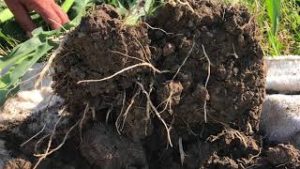
This winter’s weather so far has been rough on the wheat crop but has been good for our soils. The combination of heavy rains to recharge our soil moisture and periods of very cold temperatures on bare ground is very helpful. This time last year, we were very concerned about the condition of NW Ohio’s soils after harvesting the 2011 crop under less than ideal conditions. The winter after harvest was just a continuation of the prolonged period of saturated soils that rob microbial life of oxygen to break down crop residue. Not to mention the lack of freezing and thawing to rebuild soil structure. Early in the spring we experienced a dry period that allowed for improved soil conditions and a pretty good looking seedbed to plant into. However, not all the damage had been undone. After a couple of hard rains in May, old problem areas and traffic from the previous fall began to show up. When we hit the prolonged dry weather in summer it was obvious that there were significant problems with soil structure and health remaining in many fields. Plants that had difficulty establishing a good root system early were showing stress long before other plants in adjacent fields, or even the same field.
The dry weather itself was helpful in repairing damaged soil by promoting fracturing, just like the deep freezing this winter. However, it takes more than fracturing of the surface profile to repair soil structure and promote good tilth. The organic matter fraction, especially the active organic fraction is very important in building strong, stable soil aggregates that resist compaction from rainfall and traffic. The crop residues that are left on the field have to be digested by the bacteria and fungi that live in the soil. Residues that have been completely broken down and digested are in a form called humus, which has no resemblance to the original residue and is very stable. It is the presence of these humic substances in mineral soils that promotes granular soil structure. Humus also has the capacity to hold many times its weight in water, which increases soil water holding capacity. Not to mention its ability to hold and supply nutrients in forms that are readily available to plants.
The soil microorganisms (bacteria, fungi, and actinomycetes) that convert plant residues into humus need to be active and flourishing. As mentioned in the previous blog post by Dusty Sonnenberg, special soil tests are available that can test for the presence of these microorganisms and how many of them are active. Tests done by Widmer and Associates last year on production soils in this area revealed that total bacteria and fungi were high. However, active bacteria and fungi were below expected levels. In order to avoid having “dead” soils, we must provide an environment where populations of these active microorganisms can grow and they can do their job. Tight, compacted, water logged soils like we ended up with in 2011 are not the proper environment. Once we have a healthy, functioning microbial population, the process of cycling residues into humic substances creates its own ideal environment. This environment and the carbon cycling process that creates it can be self-sustaining. What you end up with is a friable soil with good granular structure that resists compaction and has improved water holding capacity. It is also a good rooting medium for plants that allows roots to grow deeper and be more profuse. There are things that can be done to jump start this process and promote soil health and a flourishing active organic soil fraction. For more information, contact the Widmer and Associates agronomy team.



